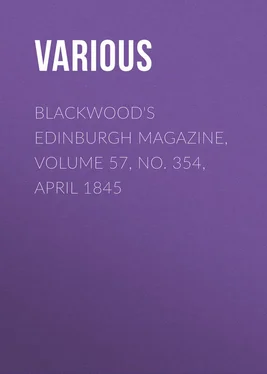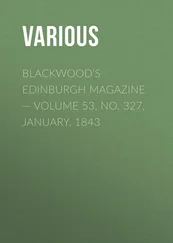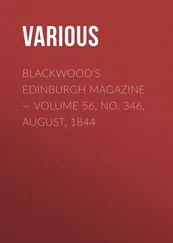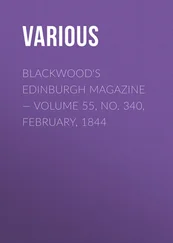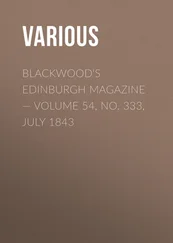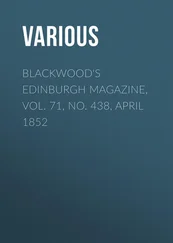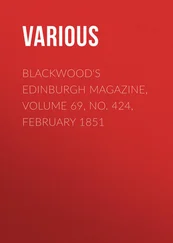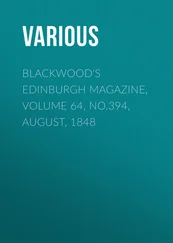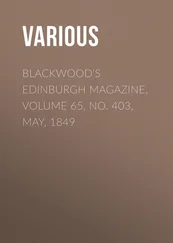Various - Blackwood's Edinburgh Magazine, Volume 57, No. 354, April 1845
Здесь есть возможность читать онлайн «Various - Blackwood's Edinburgh Magazine, Volume 57, No. 354, April 1845» — ознакомительный отрывок электронной книги совершенно бесплатно, а после прочтения отрывка купить полную версию. В некоторых случаях можно слушать аудио, скачать через торрент в формате fb2 и присутствует краткое содержание. Издательство: Иностранный паблик, Жанр: periodic, foreign_edu, Путешествия и география, на английском языке. Описание произведения, (предисловие) а так же отзывы посетителей доступны на портале библиотеки ЛибКат.
- Название:Blackwood's Edinburgh Magazine, Volume 57, No. 354, April 1845
- Автор:
- Издательство:Иностранный паблик
- Жанр:
- Год:неизвестен
- ISBN:нет данных
- Рейтинг книги:3 / 5. Голосов: 1
-
Избранное:Добавить в избранное
- Отзывы:
-
Ваша оценка:
- 60
- 1
- 2
- 3
- 4
- 5
Blackwood's Edinburgh Magazine, Volume 57, No. 354, April 1845: краткое содержание, описание и аннотация
Предлагаем к чтению аннотацию, описание, краткое содержание или предисловие (зависит от того, что написал сам автор книги «Blackwood's Edinburgh Magazine, Volume 57, No. 354, April 1845»). Если вы не нашли необходимую информацию о книге — напишите в комментариях, мы постараемся отыскать её.
Blackwood's Edinburgh Magazine, Volume 57, No. 354, April 1845 — читать онлайн ознакомительный отрывок
Ниже представлен текст книги, разбитый по страницам. Система сохранения места последней прочитанной страницы, позволяет с удобством читать онлайн бесплатно книгу «Blackwood's Edinburgh Magazine, Volume 57, No. 354, April 1845», без необходимости каждый раз заново искать на чём Вы остановились. Поставьте закладку, и сможете в любой момент перейти на страницу, на которой закончили чтение.
Интервал:
Закладка:
Modern painting, as it appears in the works of Michael Angelo, Raphael, and Titian, is an art as elevated in kind as the highest flights of the epic or tragic muse, and it has been brought to a perfection to be paralleled only by the greatest conceptions of Grecian statuary. If called upon to assign the arts which human genius had, since the beginning of the world, brought to absolute perfection, no one would hesitate to fix on Grecian sculpture and Italian painting. Imagination can conceive a more faultless poem than the Iliad , a more dignified series of characters than those of the Æneid , a more interesting epic than Paradise Lost ; but it can figure nothing more perfect than the friezes of Phidias, or more heavenly than the Holy Families of Raphael. It is one of the most extraordinary and inexplicable facts recorded in the history of the human mind, that these two sister arts should both have been brought to perfection near each other, on the shores of the Mediterranean, in the lifetime of a single generation; for the transition from the marbles of Ægina to those of the Parthenon, made in the lifetime of Pericles, is as great as from the paintings of Pietro Perugino to those of Raphael, made in the lifetime of Leo X.
The sculpture of antiquity aimed chiefly, if not entirely, at the representation of a single figure . Even the procession on the frieze of the Parthenon is not sculpture – it is a series of isolated horsemen or figures passing. The group of Niobe and her children is the only attempt extant at telling a story, or representing emotion by a variety of figures. Within this limited range, the great sculptors carried the art to the highest imaginable perfection. The Apollo is the most perfect representation of manly beauty, the Venus of feminine grace and delicacy. The Laocoon exhibits the most fearful contortions and agonized expressions of pain and anguish in suffering humanity; the Fighting Gladiator – the most inimitable representation of war-like energy at its extreme tension – the Dying Warrior of the Capitol, of valour sinking beneath the ebbing stream of blood. The Hercules Farnese is the perfection of physical strength, the Jupiter Tonans of awful majesty, the Venus Calipyge of alluring beauty. Thus the expression of character was their great object; emotion was not overlooked, but it was studied only as it brought out or illustrated the permanent temper of mind. A collection of ancient statues is a vast imaginary gallery, in which, as in the heroes of the Iliad , every conceivable gradation of the human mind is exhibited, from the stern vengeance of Achilles, whom not even the massacre of half the Grecian host could melt, to the tender heart of Andromache, who wept her husband's valour, and her sad presentiments for her infant son.
In modern painting, as it appeared in the hands of Raphael and Michael Angelo, a wider range was attempted: more spiritual and touching objects had come to engross the human mind. The mere contemplation of abstract character – its delineation by the graphic representation of the human form, had ceased to be the principal object of genius. The temple of the unknown God was no longer to be filled with idols made under image of man. The gospel had been preached to the poor; the words of mercy and peace had been heard on the earth. Painting had come to be the auxiliary of religion; it was in the churches of a spiritual and suffering faith that its impression was to be produced. Calvary was to be presented to the eye; the feeling of the centurion. "Truly this man was the Son of God," engraven on the heart. It was to the faithful who were penetrated with the glad words of salvation, that the altar-pieces were addressed; it was the feeling of the song of Simeon that had gone forth on the earth. It was those divine feelings which painting, as it arose in modern Europe, was called to embody in the human form; it was to this heavenly mission that the genius of Italy was called. And if ever there was a mind fitted to answer such a call – if ever the spirit of the gospel was breathed into the human breast, that mind and that breast were those of Raphael.
Michael Angelo was the personification of the genius of Dante. The bold conceptions, the awful agonies, the enduring suffering which are brought forth in that immortal poet, had penetrated his kindred spirit, and realized the Inferno in the representation of the Last Judgment . But it was the Spirit of Christ which had been breathed into the heart of Raphael. The divine words, "Suffer the little children to come unto me, and forbid them not, for of such is the kingdom of heaven," had inspired his immortal conceptions. It is neither physical beauty nor mental character, as in the Greek sculpture, which is represented in his paintings. It is the Divine spirit breathed into the human heart; it is the incarnation of deity in the human form that formed the object of his pencil. He has succeeded in the attempt beyond any other human being that ever existed. If any works of man ever deserved the name of divine, they are the Holy Families of Raphael.
Superficial writers will ask, what has Raphael to do with Virgil? mere artists will enquire, how they are to be benefited by the study of Tasso? Those, again, who have reflected on the means by which the higher stages in any art are attained, will acknowledge that, at a certain elevation, their principles are the same.
To move the heart, whether by painting, poetry, or eloquence, requires the same mind. The means by which the effect is to be produced are not different. The one works, indeed, with the pencil, the other with the pen; the one composes in verse, the other in prose – but what then? These are the means to the end, they are not the end itself. There are many avenues to the human heart, but the inner doors in them all are to be opened only by one key, and that key is never denied to the suit of genius.
It is in his lesser pieces that the exquisite taste and divine conceptions of Raphael are chiefly to be seen. His greater paintings, the Transfiguration , the frescoes in the Vatican, the cartoons, are invaluable to the artist as studies, and specimens of the utmost power of drawing and energy of conception; but it is not there that the divine Raphael appears. In the larger ones his object was to cover space and display talent; and in the prosecution of these objects he never has been exceeded; but it is in his groups of two or three figures that his exquisite conceptions appear. It is there that he has given free scope to his exquisite conception, intended to represent in the maternal, and therefore universally felt affection, the divine spirit and parental tenderness of the gospel. "My son, give me thy heart," was what he always aimed at. "God is love," the idea which he ever strove to represent, as embodying the essence of the Christian faith. The Madonna della Seggiola at Florence, the Assumption of the Virgin at Dresden, the Madonna di Foligno in the Vatican, the Holy Family at Naples, St John in the Desert in the Tribune at Florence, the small Holy Family in the Louvre, the large Holy Family, with the flowers, brought from Fontainbleau, also in the Louvre, St Mark at Munich, and several of the lesser pieces of Raphael in the same rich collection in that city, are so many gems of art, embodying this conception, which to the end of the world, even when preserved only in the shadowy imitation of engraving, will improve the heart and refine the mind, as well as fascinate the imagination. It may be doubted if they ever will be equalled: excelled they can never be.
Whoever will study those inimitable productions, even when standing to gaze at the engravings from them in a print-shop window, will have no difficulty in feeling the justice of Cicero's remark, that all the arts which relate to humanity have a certain common bond, a species of consanguinity between them. The emotion produced by the highest excellence in them all is the same. So intense is this emotion, so burning the delight which it occasions, that it cannot be borne for any length of time: the mind's eye is averted from it as the eyeball is from the line of "insufferable brightness," as Gray calls it, which often precedes the setting of the sun. It is difficult to say in which this burning charm consists. Like genius or beauty, its presence is felt by all, but can be described by none. It would seem to be an emanation of Heaven – a chink, as it were, opened, which lets us feel for a few seconds the ethereal joys of a superior state of existence. But it is needless to seek to define what, all who have felt it must acknowledge, passes all understanding.
Читать дальшеИнтервал:
Закладка:
Похожие книги на «Blackwood's Edinburgh Magazine, Volume 57, No. 354, April 1845»
Представляем Вашему вниманию похожие книги на «Blackwood's Edinburgh Magazine, Volume 57, No. 354, April 1845» списком для выбора. Мы отобрали схожую по названию и смыслу литературу в надежде предоставить читателям больше вариантов отыскать новые, интересные, ещё непрочитанные произведения.
Обсуждение, отзывы о книге «Blackwood's Edinburgh Magazine, Volume 57, No. 354, April 1845» и просто собственные мнения читателей. Оставьте ваши комментарии, напишите, что Вы думаете о произведении, его смысле или главных героях. Укажите что конкретно понравилось, а что нет, и почему Вы так считаете.
